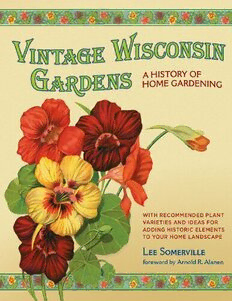
Vintage Wisconsin Gardens : a History of Home Gardening. PDF
Preview Vintage Wisconsin Gardens : a History of Home Gardening.
Published by the Wisconsin Historical Society Press Publishers since 1855 © 2011 by the State Historical Society of Wisconsin E-book edition 2013 For permission to reuse material from Vintage Wisconsin Gardens: A History of Home Gardening, (ISBN 978-0-87020-475-3; e-book ISBN 978-0-87020-658-0), please access www.copyright.com or contact the Copyright Clearance Center, Inc. (CCC), 222 Rosewood Drive, Danvers, MA 01923, 978-750-8400. CCC is a not-for-profit organization that provides licenses and registration for a variety of users. wisconsinhistory.org Photographs identified with WHi or WHS are from the Society’s collections; address requests to reproduce these photos to the Visual Materials Archivist at the Wisconsin Historical Society, 816 State Street, Madison, WI 53706. Back cover: WHi Image ID 27008 Frontmatter photo credits: page v: Cadwell & Jones, 1900 Catalogue of Seeds and Agricultural Implements; page vi: Vick’s Monthly Magazine, November 1878; page viii: Vick’s Monthly Magazine, February 1879; page xii: Vick’s Monthly Magazine, June 1882; pages xiv–xx: illustrations adapted from Vick’s Monthly Magazine, June 1879; page xvi: Vick’s Monthly Magazine, November 1879. Designed by Steve Biel 15 14 13 12 11 1 2 3 4 5 The Library of Congress has cataloged the printed edition as follows: Somerville, Lee. Vintage Wisconsin gardens : a history of home gardening / Lee Somerville ; foreword by Arnold R. Alanen. p. cm. Includes bibliographical references and index. ISBN 978-0-87020-475-3 (pbk. : alk. paper) 1. Gardening—Wisconsin—History. 2. Gardens—Wisconsin—History. I. Title. SB451.34.W6S66 2011 635.909775—dc22 2011001830 Dedicated to Wisconsin gardeners, past, present, and future Contents FOREWORD ACKNOWLEDGMENTS INTRODUCTION 1 Changing Ideals in Nineteenth-Century American Vernacular Gardens 2 From Farmstead to Village 3 The Pleasures and Benefits of Amateur Horticulture 4 Beautifying the Home Grounds 5 Graceful Vines and Sweet Wild Roses: Recommended Plants 6 In the Wisconsin Garden—Yesterday and Today APPENDIX: RECOMMENDED VARIETIES NOTES SELECTED BIBLIOGRAPHY INDEX Foreword Any observant person who travels throughout present-day Wisconsin cannot help but notice that well-tended, orderly, and often imaginative gardens, yards, and lawns appear in abundance throughout the state. Whether in rural, suburban, or urban areas, many Wisconsin residents take a strong interest in creating, making, and maintaining the outdoor spaces that serve as settings for their homes and farmsteads. The origins of these present-day residential spaces, which collectively form a major portion of the state’s overall cultural landscape, may be traced back to the mid-nineteenth century—a time when some areas of Wisconsin began to undergo the transition from frontier conditions to a more domesticated and “civilized” environment. Granted, the changes did not occur overnight, even as Wisconsin achieved statehood in 1848 and its population expanded from 31,000 in 1840 to 776,000 in 1860. During this twenty-year period Wisconsin’s American- and foreign-born residents mined ore, developed townsites, and cleared land for agricultural purposes. Following the end of the Civil War in 1865, the foundation for Wisconsin’s quintessential dairy farm landscape began to emerge, and its towns and cities attracted increasing numbers of inhabitants. By 1920, when the population total exceeded 2.6 million people, the state’s settlement framework was in place, and Wisconsin was fully integrated into all facets of national life and activity. It is the period described above, from the 1840s to 1930, that Lee Somerville covers in Vintage Wisconsin Gardens: A History of Home Gardening. Unlike the majority of American garden history books, which focus on formal and “high style” examples, this volume features vernacular gardens— the outdoor spaces that Wisconsinites themselves created for their own use and enjoyment. For the most part, these people did not have access to a professional landscape designer, or the monetary resources to hire one; however, there was an organization that could provide them with free garden- related advice: the Wisconsin State Horticultural Society, formed during the
